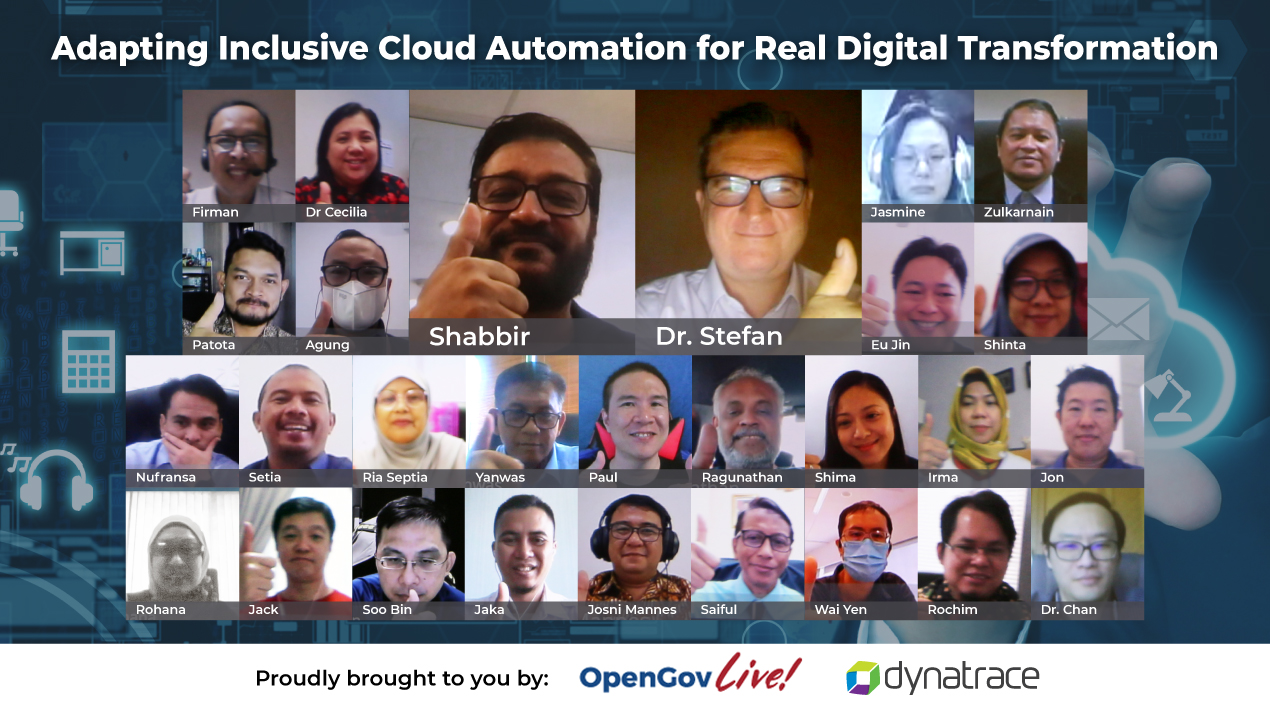
With the emphasis on government digitalisation, new technologies that the public sector can use are eagerly sought after. Cloud is at the top of this list due to it being one of the essential requirements for a strategic organisation. The ability to manage, configure and automate complex systems using the cloud has the potential to achieve an organisation’s vision and goals.
Southeast Asian nations with significant digital goals and strategies, like Singapore, Malaysia, and Indonesia, are expected to continuously develop and adapt to new systems and technologies that promote diversity, provide employees and residents more access and provide a better overall experience.
It’s become even more important for both private and public organisations to provide the citizens with a good digital service experience. Precise cloud systems provide a way to adapt accurate and actionable insights and adding software intelligence on top of that gives executives a solution to complex cloud issues.
The OpenGovLive! Virtual Breakfast Insight focused on adapting inclusive cloud automation for real digital transformation.
Digital Technology in Response to the pandemic

Mohit Sagar, CEO and Editor-in-Chief started the session by acknowledging that a digital transformation strategy could help businesses get ready for a future where technology is the main driver of the economy.
“To maintain business continuity, firms must have the capacity to access company computers and files rapidly, reliably and securely – especially as the proportion of remote workers and employees who work from home rises,” Mohit stresses.
Digital technologies and processes make it easy for businesses to meet customer needs. It can also make it easier for agencies to work together, let people work from home, improve data insights and keep trusted services running without halting.
Moreover, digital transformation builds the infrastructure and skills that are needed to take advantage of technologies that change quickly and could give a business a competitive edge.
When the pandemic struck, government agencies had to quickly figure out how to switch from giving services in-person to offering services digitally and virtually. At the same time, agencies had to make sure that operations, processes and governance would continue as usual.
Government agencies that were already on a digital transformation path had an advantage and were more equipped to transition with agility and speed.
Mohit underscored his point with the example of the contact tracing app in Singapore and Malaysia which provides real-time contact tracing to promptly identify and manage local outbreaks and estimate medical resource requirements.
Later, technology became the key to speeding up the distribution of the vaccine and figuring out how long the immunity lasts after vaccination by using real-world data from all over the world. This helps assess the risk of reinfection and figure out when the vaccine needs to be given again.
An organisation may be able to work through its complex systems to achieve its vision and goals if it has cloud integration, automation, configuration, and management all in one package. “Cloud can be used to deploy services and a data centre will serve as a fixed asset for a country that will benefit the future of your organisations for a long time,” Mohit concludes.
The World is Changing: Dynamic Multi-Clouds are the Platform of Choice

According to Shabbir Baliwala, APAC Solutions Sales Director at Dynatrace, 86% of organisations are using cloud-native technologies and platforms such as Kubernetes, Microservices, and Containers. “Even the government is transferring to the cloud,” he says. On the other hand, based on the Global CIO report, the pressure on IT continues to rise as 46% of Chief Information Officers (CIOs) agreed that their IT teams are stretched more thinly than ever.
CIOs supervise the people, processes and technologies within a company’s IT organisation to ensure they deliver results that support the business goals. Some challenges that CIOs encountered were:
- Increased number of IT performance-related issues
- The shift to a remote working model
- Increased and sudden surges in demand for cloud services
- Supporting rapidly changing business needs
- Managing user experience with so many remote users and such high demand
Large IT infrastructures frequently include components from various manufacturers. Additionally, they use many system types, each of which has its own IT monitoring tools for tracking things like network performance, storage, databases, and applications.
Numerous monitoring systems attempt to provide a single picture of the network, but many fall short. Many IT professionals lack the necessary skill set to monitor large infrastructures, which resulted in major complaints from their respective clients.
“The problem with monitoring is that you end up with lots of different monitoring tools that are providing teams with conflicting data and noise that makes it impossible to be proactive,” Shabbir explains.
In the new world of cloud, Kubernetes, Containers and Microservices, these traditional tools fail to provide value. However, while observability can provide some basic visibility in modern, cloud-native environments, it still has significant blind spots and requires a significant amount of human effort to set up, instrument, and manage.
Both approaches do have value, but they’re simply not good enough. They still leave the following: too many expensive war rooms, being too reactive, and being left guessing at what the root cause of the problem.
The major problems will be shouldered by the company because:
- Companies make the solution operational across a large enterprise;
- Should keep it properly configured and up to date with dynamic, frequently changing environments; and
- have to find the answers to problems
“These burdens are always carried by every company, and they do not scale,” Shabbir furthers. “When all technological development moves to become cloud-native, DevOps practices start to become the norm.”
Shabbir clarified that DevOps principles allow software development (Dev) and operations (Ops) teams to expedite delivery through automation, feedback, and teamwork resulting in improvement. On the other hand, cloud-native technologies allow organisations to build and run scalable applications in modern, dynamic environments.
“When we talk about Cloud, we are talking about the new architectures based on containers, microservices and software-defined cloud infrastructure – the combined operational complexity causes organisations to hit a wall.”
Shabbir refers to the old way of doing things which no longer work such as environment scale, complexity and fluidity that are beyond human capacity, and beyond most tools which needed a different approach to continue the pace of innovation.
He concludes that this is not a problem that will go away easily; data will continue to grow, the scale will continue to grow exponentially and customer expectations will continue to rise as scarce resources scramble to keep up.
Breaking the wall
According to Shabbir, there are three approaches to breaking those “walls.”’
First is the DIY approach, which needs to gather all the data requiring scripting, configuration, and often special tooling – across metrics, traces, and logs. There is an unmanageable amount of data sources; even just looking at metrics, monitoring vendors and the cloud platform metrics to figure out.
Next, all that data needs to be stored in a shared repository. But it still lacks the context of how everything is related to truly understand what is going on. This is where teams spend their time continuously and manually organising the data to figure out relationships, baselines, and problem patterns.
People also need to suppress the noise by continually adjusting baselines, setting filters for alerts, and trying a time and event-based correlation engine.
Many teams are constantly spending cycles building dashboards and adding reporting engines for use by dev, ops, and business, and then creating variations for each app, team, and more. And, as teams spend more and more time building a custom solution, it still needs to scale to meet the demands of more apps, new technologies, massive data flow, new relationships and new baselines.
DIY Observability approaches seem easy at first but it requires the best talent, steals time from innovation, and aren’t scalable even over a short period. They are a distraction that enterprises cannot afford and an opportunity for their partners to demonstrate their thought leadership.
The All-In-One Observability (and beyond), on the other hand, is an automated, intelligent, comprehensive approach that does the heavy lifting for organisations at speed, at scale and with precision, to provide the best solutions.
Dynatrace, through OneAgent and support for over 600 technologies out of the box, seamlessly captures metrics, traces, and logs data from a variety of sources, including cloud platforms and open telemetry. But it also captures rich contextual information around the data – topology, behaviour, code performance, metadata and network data.
Dynatrace, through DAVIS AI, intelligently organises the data and provides automatic dashboards, problem identification and precise root cause based on actual causation, not correlation.
“And this provides answers. Answers that enable a rich set of partner services offering that we’ll cover in a moment,” says Shabbir. “It’s a journey where we set the vision for how modern enterprise IT teams should operate, while our partners drive tool and product replacement like on subscription expiry and the services to implement Dynatrace in place of the legacy tools.”
Adapting Inclusive Cloud Automation for Real Digital Transformation

Stefan Harrer, PhD, Chief Innovation Officer, Digital Health CRC Ltd is convinced that the opportunity to invest in the policies, people, processes, and technologies that will enable the leveraging of data to improve health systems and health outcomes for billions of people, will arise from the strengthening of health systems through the design and deployment of digitally-enabled solutions.
“Digital health is a consumer-driven services business in which data flows from patients to patients and is transformed into services along the way,” says Stefan.
Digitally-enabled health systems, using digital health technologies to improve the quality and reach of important health information and services for the public good, requires a data flow that is made possible by an integrated platform that acts as a data marketplace.
Users and providers who share data and insights across interfaces transform data into value for business and medicine. These transactions can only take place if all three flow levels – technical, regulatory and business – are opened simultaneously.
The idea of a digital value chain outlines how a company acquires raw materials, transforms them into goods, distributes them, sells them via markets, and then provides services. Each step adds value, and as a result, boosts the firm’s profits.
Depending on the interface, the roles of user and provider are fluid ideas in the healthcare system. For instance, an EHR functions as a user when it receives data from patients, and as a provider when it sends that data to those who create analytical models.
On the other hand, by enabling and operating this data marketplace with the healthcare as a service (HaaS) platform, the financial value is derived. “Telehealth and Virtual Care describe the delivery of health services from carers and providers to patients as consumers. It is at this interface where value is returned to patients,” Stefan explains.
The common denominator of organisations that underperform in the strategy domain is the absence of a well-defined cloud adoption objective. Some fail to comprehend and adapt to the operating expense approach of the cloud model. “Develop a blueprint for successful transformations and have a fair approach to analyse data to drive meaningful insight,” advises Stefan.
The pandemic has made it necessary to advance the digital transformation of healthcare and is acting as a catalyst for this change. Despite this potential, many healthcare organisations, payers, and providers have not fully tapped into the cloud’s benefits.
Data analytics helps businesses, and even the healthcare sector becomes more efficient and finds new opportunities that will make their customers happy. This will only happen if organisations should have a dynamic database management system.
“Along with the scale and flexibility that the cloud may offer an organisation, it can also help you deliver speed, quality, and value to your consumers,” Stefan reiterates. “Delivering the needs of the consumers is the real meaning of digital transformation.”
Interactive discussion
After the talks, the delegates took part in discussions that were prompted by polling questions. OpenGovLive! Virtual Breakfast Insight is meant to give live audience interaction, encourage participation, let people hear about real-life experiences, and help participants learn and grow professionally.
On being asked what their agency’s cloud environment looks like, a majority (42%) answered hybrid cloud, while others opted for no cloud – build a data centre (32%); public cloud (16%) or private cloud (10%).
A delegate cited that with a hybrid cloud, a business can get a lot of different things. They can use cloud services where they work best and keep doing other things on-premises or in a private cloud. Another shared that there are different hybrid cloud architectures, but it is important to protect their hybrid cloud environment no matter which they choose.
Inquiring if their organisation has plans to move from critical citizen services to the public cloud in the next 12 months, most (40%) answered yes while 35% said no. The reaming quarter was unsure and opted for maybe.
Regarding the biggest challenge that their organisation is facing, delegates were evenly divided between management and visibility of complex IT environment (33%) and cross-team collaboration on digital services due to conflicting data from multiple tools (33%). Others went with using valuable resources for detecting root cause analysis manually and correcting issues manually (13%) or building agile DevOps practices (13%).
A delegate felt they need to understand the IT ecosystem first before they move into the cloud while another said they have developed the application platform. On the other hand, the most challenging one is driven by where they are least skilled or where the demands are the most unreasonable, opined a third participant.
When asked how their company deals with issues of availability and performance, over half (56%) answered retrieving data/waiting a few seconds and trying to cut or copy again, while the rest (44%) indicated that they look at the issues post-mortem to identify potential weakness.
A delegate shared they do have the data and feedback then they identify the issues and discussed with their team to resolve the problem by using all the channels that they have and anticipate the problems and several issues.
The last question asked the delegates how often automated DevSecOps practice is used to update critical citizen services and launch new releases. Half (50%) shared that DevSecOps practice is in consideration, while others indicated either monthly new releases (44%) or bi-weekly new releases (6%).
Conclusion
It can be overwhelming to move to the cloud. There are worries about stability, costs and, most importantly, safety. Many people find that a successful cloud migration lowers costs, makes it easier to scale, and makes it much less likely that a cyber incident will happen which could ruin their business.
“It is important to recognise the benefits of a reliable partner when migrating toward the cloud. Select a partner with in-depth knowledge of cloud migration, best practices, and insights gained from successful migrations,” says Shabbir.
He added that each cloud migration process is unique and when done right, the cloud can be safer than traditional network systems when it comes to security.
Stefan emphasised the significance and possibilities of developing digital health ecosystems, especially for stakeholders in the healthcare industry. He understands the healthcare players’ roles might vary greatly depending on each one’s market, strategy, clientele and position along the value chain.
The opportunity exists for large IT companies to demonstrate how their services have altered the entire value chain of digital health.
Stefan added that tech businesses which have created standards have a wide range of possible partners that are eager to create solutions independent of users and vendors and to showcase the possibilities of health IT platforms.
“Cloud migration is an investment and an opportunity to solve problems,” he ended.
















